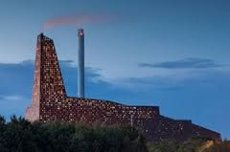New publications
An energy tower with an original design was opened in Denmark
Last reviewed: 02.07.2025

All iLive content is medically reviewed or fact checked to ensure as much factual accuracy as possible.
We have strict sourcing guidelines and only link to reputable media sites, academic research institutions and, whenever possible, medically peer reviewed studies. Note that the numbers in parentheses ([1], [2], etc.) are clickable links to these studies.
If you feel that any of our content is inaccurate, out-of-date, or otherwise questionable, please select it and press Ctrl + Enter.

Recently, Crown Prince Frederik of Denmark inaugurated a power and heat tower designed by Dutch architect Erik van Egeraat. The new power plant is capable of meeting Roskilde's (Denmark) electricity and heat needs using waste from nine nearby municipalities.
Dutch architect Erik van Egeraat has completed his design for a waste incineration plant and power plant in the Danish city of Roskilde. The power plant uses the latest technology and is distinguished by its distinctive appearance.
The construction of such power plants is a rather important step towards the implementation of the Danish government's program to reduce the amount of waste in landfills, in addition, the new power plant in Roskilde has significantly improved the city landscape with its unusual appearance.
Erik van Eregaat won the design competition in 2008 and was chosen as the project architect. Eregaat's design, submitted to the competition, was a perfect fit for the flat terrain of Roskilde and received a lot of support from the city's residents.
Now the city is dominated by a spire, over 90 metres high, framing the power plant's chimney. The front of the building is made of two parts - an internal one (to provide a climate barrier) and an external one. The external layer is covered with aluminium plates, in which round holes of various shapes are laser-cut for decoration.
At dusk, a special backlight is turned on on the building's façade, turning the power plant into a kind of beacon symbolizing the production of electricity. The testing period of the lamps took quite a long period of time, since the architect set high demands on the lighting, first of all, it was necessary to achieve the technical ability of the lamps to implement a non-standard lighting plan. Also, each lamp had to be controlled individually and provide the overall expressiveness of the building, in addition, the ability to illuminate a rather complex projection surface and have the necessary power and brightness was taken into account. Of course, the main condition of the project was low power consumption.
More than a hundred lamps and about 80 LED strips, controlled by software developed individually for the project by Martin Professional, coped well with these tasks.
The construction cost more than 1 billion Danish kroner, not counting the interest costs. The new power plant supplies about 65 thousand homes and 40 thousand households with heat and electricity.
At the last Roskilde Festival, even before the official opening, the power station glowed orange, symbolising the colour of the festival and illuminating the main stage of the festival.
In addition, another distinctive feature of the power plant is the ability to change the image with the help of futuristic lighting design, which was developed based on various actions designed to show the viewer the basics of obtaining electricity through waste recycling through certain themes.
 [ 1 ]
[ 1 ]
